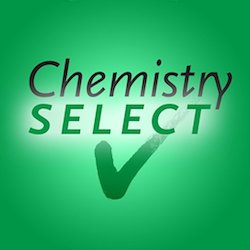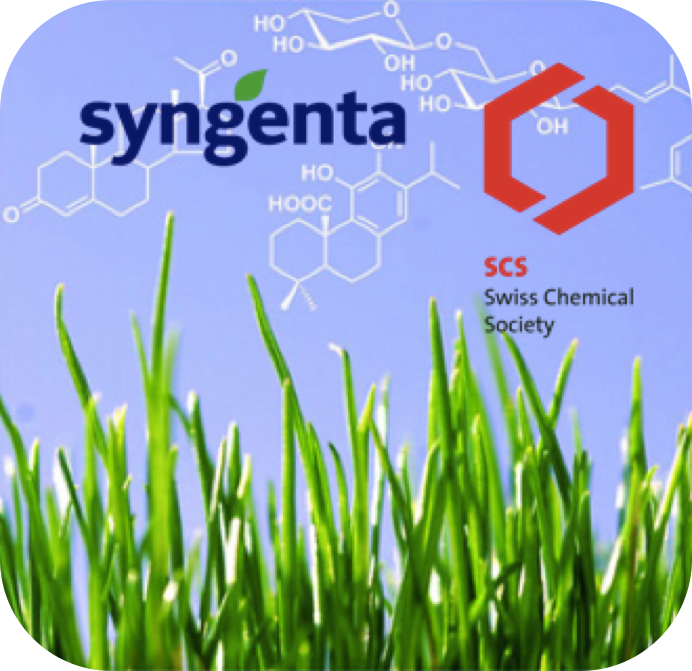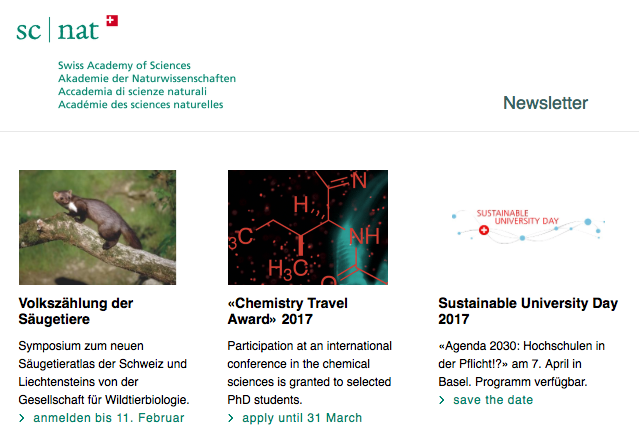ChemistrySelect has been accepted into the Web of Science
 ChemistrySelect has been accepted into the Web of Science (Science Citation Index Expanded). Three issues have so far been indexed (issues 1, 2, and 13 from 2016) and Anne Deveson, editor-in-chief of ChemistrySelect, hopes to see the rest indexed soon. In 2016 ChemistrySelect received over 2000 submissions and published over 1000 papers. Submissions in 2017 are already indicating an upward trend.
ChemistrySelect has been accepted into the Web of Science (Science Citation Index Expanded). Three issues have so far been indexed (issues 1, 2, and 13 from 2016) and Anne Deveson, editor-in-chief of ChemistrySelect, hopes to see the rest indexed soon. In 2016 ChemistrySelect received over 2000 submissions and published over 1000 papers. Submissions in 2017 are already indicating an upward trend.
Follow ChemistrySelect Twitter
Wiley online library: Chemistry Select
Contact:
Anne Deveson, Editor-in-Chief
David Spichiger, SCS
20.02.2017
Brussels News Update, February 2017
European Highlights
EuCheMS Provides Input for the Revision of European Code of Conduct for Research Integrity
The current Code of Conduct for Research Integrity is from 2011 and should be updated in the beginning of 2017, following a request from the European Commission, thus reflecting these last years´ changes in scientific research and in society. EuCheMS is providing input through Prof. Hartmut Frank, the Chair of EuCheMS Working Party…
| read more |
Welcome to Chemistry in Europe
You are cordially invited to subscribe to Chemistry in Europe, EuCheMS new newsletter. Its objective is to inform about research in Europe, to provide highlights from EuCheMS Member Organisations and Professional Networks, and to look into policy related developments. You can subscribe to this new newsletter here.
Source: http://www.euchems.eu/
Employment Survey for European Chemists
2nd Employment Survey for European Chemists will open on the 1 March 2017. This survey will look into the current employment situation for chemists and chemical engineers across Europe and will be a valuable tool in quantifying job market needs and educational offer in the field of chemistry. The full report of…
| read more |
Creating Rubies with Chemistry
this interview recently conducted by EuCheMS, readers will meet Christian Schärf, Paul Rathke, and Friedrich Wanierke, the winners of the 2016 European Union Contest for Young Scientists (EUCYS) EuCheMS Award. Their research project, “Alpha-aluminium oxide-based gemstones: Development of a chemical synthesis process prompted by current mining conditions”, started from their interest in…
| read more |
Chemistry Rediscovered – A European Competition
The Chemistry Rediscovered contest intends to promote chemistry among young high-school students from all Europe. This will be achieved with the help of teachers, who will develop scientific projects together with their students and encourage them to present their findings, in the form of a video-experiment, together with an accurate experimental protocol.
Deadline: 17 February 2017
| read more |
Circular Economy Package: 2017 perspectives
Roughly one year after adopting its Circular Economy Package, the European Commission (EC) reported on the delivery and progress of key initiatives of its December 2015 Action Plan. In the last year the EC has taken measures in areas such as waste, ecodesign, food waste, organic fertilisers, and innovation and investment. Circular economy…
| read more |
Antonio Tajani elected new President of the European Parliament
Antonio Tajani (EPP, IT) won the Parliament’s presidential election. Among other responsibilities, the President of the European Parliament (EP) ensures that parliamentary procedures are properly followed, oversees Parliament's various activities and committees, represents EP in all legal matters and in its international relations, and provides his final agreement to the EU budget. The EP is…
| read more |
Environmental Implementation Review: Chemistry Heavily Needed
Earlier this month, the European Commission (EC) presented the Environmental Implementation Review, a tool to improve implementation of EU environmental policy. The review includes three elements: 1) 28 country reports, providing an overview of how environmental policy and legislation are being implemented, and what the identified strengths and weaknesses are in each Member…
| read more |
The priorities of the Maltese Presidency Discussed at European Parliament Committees
The priorities of the Maltese Presidency of the EU Council were outlined to parliamentary committees by Maltese ministers at a series of meetings taking place in January and February. At the Industry, Research and Energy (ITRE) Committee, the Maltese Parliamentary Secretary for Research, Innovation, Youth and Sport Chris Agius pointed PRIMA (the partnership for…
| read more |
EFSA to Live Webstream Open Scientific Meetings in 2017
The European Food Safety Authority (EFSA) is increasing its transparency to stakeholders by introducing video streaming of open meetings of its Scientific Panels. This is intended to boost the number of observers by allowing remote attendance. Online submission of questions to EFSA’s scientists will also be possible.
Source: http://www.efsa.europa.eu/
| read more |
OpenFoodTox: Open Access to Scientific Output
OpenFoodTox is the new European Food Safety Authority (EFSA) database that provides instant access to a wealth of information from over 1,650 EFSA scientific outputs about the toxicity of chemicals found in the food and feed chain. Since its inception in 2002, has produced risk assessments for more than 4,400 substances in over 1,650 Scientific…
| read more |
Eurachem/CITAC Guide to Quality in Analytical Chemistry
The aim of this Guide is to provide laboratories with guidance on best practice for the analytical operations they carry out. This third edition reflects changes that were introduced with the publication of the 2005 version of ISO/IEC 17025. The terminology has also been updated to take account of ISO/IEC 17000:2004, ISO 9000:2015 and the…
| read more |
European Professional Card
The European Professional Card (EPC), created to help EU professionals move within the EU more easily, was launched one year ago. EPC is the result of joint efforts and efficient cooperation between the European Commission and public administrations in EU countries. The EPC targets the most mobile professions. Currently, it applies to nurses responsible for…
| read more |
Happy Birthday Erasmus
The European Commission has launched in January the celebrations of the 30th anniversary of the start of Erasmus, one of the most successful programmes of the European Union. Throughout 2017 activities will highlight the positive impact of Erasmus both on individuals and society as a whole, and to give all those involved the opportunity to…
| read more |
Education and Labour Market Needs in Western Balkans
The study From University to Employment: mapping higher education provision and labour market needs in the Western Balkans focuses on higher education provision and labour market needs in the Western Balkans, offering concrete data for policy reform in both higher education and labour sectors. This study, published by The Western Balkans Platform on Education…
| read more |
2016 ERC Proof of Concept Grants
133 ERC grantees are bringing the results of their frontier research closer to the market thanks to Proof of Concept grants, awarded in three rounds during 2016. The winners of the last round have been announced in January and will receive top-up funding to explore the innovation potential of their ERC-funded discoveries. Chemistry-related research is…
| read more |
Innovation & Entrepreneurship
Horizon Prize for Better Use of Antibiotics
Earlier this month in a ceremony at the University of Leuven in Belgium, Carlos Moedas, European Commissioner for Research, Science and Innovation, delivered a €1 million Horizon Prize for Better Use of Antibiotics to a for a finger prick test that can diagnose in less than ten minutes a bacterial infection and identify if…
New Advice on Using Non-Animal Test Methods
The European Chemicals Agency (ECHA) has recently provided updated guidance giving advice on how to use non-animal test methods. The guidance takes into account the recently changed REACH (Registration, Evaluation, Authorisation and Restriction of Chemicals) information requirements, which made non-animal testing the default method for skin corrosion/irritation, serious eye damage/eye irritation and…
The New Plastics Economy
The New Plastics Economy initiative launched its latest report in January 2017 at the World Economic Forum Annual Meeting in Davos. Endorsed by 40+ industry leaders, it provides a global action plan to transition towards a plastics system that works, aligned with the principles of the circular economy.
Source: http://www.newplasticseconomy.org/
Consultations and Roadmaps
Public Consultation on the Active Substance Copper Compounds
EFSA will assess all comments from interested parties regarding the active substance copper compounds. Input is requested on the following: physical/chemical properties; details of uses and further information; methods of analysis; mammalian toxicology; residues; and environmental fate and behavior.
Deadline: 5 April 2017
Website: http://www.efsa.europa.eu/
Public Consultation on possible activities under a 'Commission Communication on a One Health Action Plan to support Member States in the fights against Antimicrobial Resistance (AMR)'
The objective of this consultation is to collect the views and input of citizens, administrations, associations and other organisations for the currently ongoing process on proposals for the Commission communication. The European Commission's 2011-2016 action plan against the rising threats of AMR was evaluated in 2016 concluding that the EU can bring added value in…
| read more |
Public Stakeholder Consultation – Evaluation of Public-Public Partnerships (Art.185 initiatives) in the context of the Horizon 2020 Interim Evaluation
The objective of the consultation is to collect information from a wide audience on different aspects of the design and implementation of the Art.185 Initiatives operating under Horizon 2020 or FP7. Art. 185 of the Treaty of the European Union enables the EU to participate in research programmes undertaken jointly by several Member States, including…
| read more |
Roadmap: Analysis of the Interface Between Chemicals, Products and Waste Legislation and Identification of Policy Options
The purpose of the initiative is to prepare the basis for a broad consultation on the problems and options. In order to prepare a factually correct Communication, the Commission will ask for input from relevant stakeholders. The Communication will present a detailed analysis of the legal, technical or practical problems at the interface of chemical,…
| read more |
Roadmap: Strategy on Plastics in a Circular Economy
The strategy aims at 1) decoupling plastics production from virgin fossil feedstock and reducing its life-cycle GHG impacts 2) improving the economics, quality and uptake of plastic recycling and reuse, and 3) reducing plastic leakage into the environment. The Strategy should seek to improve framework conditions for investments and innovations that enable the plastic and…
| read more |
Evaluation of the European Customs Inventory of Chemical Substances
The purpose of the evaluation is to assess the effectiveness, efficiency, relevance, EU added-value and sustainability of the European Customs Inventory of Chemical Substances (ECICS), and its coherence in relation to other existing databases. Since its first publication in 1974, the ECICS has been constantly extended. Despite its long life-span and its important effect on…
| read more |
EuCheMS Events
- From Waste to Health
- 25HSKIKI – 25th Croatian Meeting of Chemists and Chemical Engineers with International Participation
- Glyphosate: Harmless Chemical or Silent Killer?
- Inorganic Chemistry Days
- ICCE 2017 – 16th EuCheMS International Conference on Chemistry and the Environment
- ISOS 2017 – International Summer School on Organic Synthesis “A. Corbella”
- Bienal 2017 – XXXVI Biennial Meeting of the Spanish Royal Society of Chemistry (RSEQ)
- 7th EuroVariety - 7th European Variety in University Chemistry Education
Other Events
- Policy Recommendations for Opening Up Education
- European Industry Day
- Future of Biopharmaceutical Manufacturing High Level Seminar
- Horizon 2020 – Performance and Further Simplification
- Research and innovation staff exchange (RISE) 2016 – Coordinators’ day
- Intellectual Property Rights, Technology Transfer & Open Science: Challenges and Opportunities
- Circular Economy: 1 Year After Adoption, Working Together for the Future
- Developing the next Research Excellence Framework
Special Events
Chemistry in Europe
Read the first and the latest issue of Chemistry in Europe here
Subscribe here
7th EuCheMS Chemistry Congress
ECC7, 26 - 30 August 2018
Liverpool, UK
From Waste to Health
5 April 2017, Valletta, Malta
Website: http://www.euchems.eu/
EuCheMS aisbl - Rue du Trône 62, 1050, Brussels, Belgium; www.euchems.eu. Produced for EuCheMS by Nineta Hrastelj, Bruno Vilela and Marta Kucza. This newsletter has been carefully prepared and only contains correct information to the best of EuCheMS´ knowledge, however this does not exclude the possibility of existence of incorrect information. EuCheMS cannot be liable for the use or misuse of any information, whether correct or incorrect, present at this newsletter. Intellectual property belongs to its rightful owners, always explicitly traceable on each article. Compilation Copyright © 2017 EuCheMS
SCNAT Newsletter, February 2017
Focus Topics:
- Volkszählung der Säugetiere
- «Chemistry Travel Award» 2017
- Sustainable University Day 2017
- 2. Tagung Parkforschung Schweiz
- Wasserschloss Schweiz in Gefahr?
- Leiterin / Leiter Wissens- und Technologietransfer gesucht
- 45. Internationale Messe für Erfindungen
- weitere Veranstaltungen der SCNAT
Read the online version of the SCNAT Newsletter, Feb 2017
David Spichiger, SCS
03.02.2017
SCS Spring Meeting, April 21, 2017, Bern
![]() SCS Spring Meeting 2017
SCS Spring Meeting 2017
«Homogeneous Catalysis: New Paradigms, Wonderful Applications»
Fri, April 21, 2017; 09.00-17.30h
University of Bern, Department of Chemistry & Biochemistry,
Freiestrasse 3, 3012 Bern
The SCS Spring Meeting is an annual, one-day symposium organized by the Division of Fundamental Research (DFR) of the Swiss Chemical Society (SCS) with lectures of national and international top-experts in the field. The 2017 edition will focus on homogeneous catalysis and will show new paradigms with wonderful applications.
Speakers
- Prof. John Hartwig, Berkeley, USA
«Selective Functionalization with Small and Large Catalysts» - Prof. David Milstein, Weizmann, Israel
«Design and Applications of Sustainable Catalytic Reactions for Synthesis and Energy» - Dr. Rocco Paciello, BASF, Germany
«Homogeneous Catalysis@BASF» - Prof. Morris Bullock, Pacific Northwestern, USA
«Design of Molecular Electrocatalysts for the Production and Oxidation of Hydrogen» - Prof. Hansjörg Grützmacher, ETH Zurich
«Fun with Funny Organophosphorus Compounds» - Prof. Pedro Perez, Huelva, Spain
«Coinage metal-based catalysis for methane functionalization»
Alfred Werner Prize Ceremonies and Lectures 2017
The SCS Spring Meeting is also the platform for the Werner Price Ceremonies and the Werner Award Lectures. The 2017 winners are
- Prof. Kevin Sivula, EPF Lausanne, who was awarded for his significant contributions to the advancement of materials and methods for photoelectrochemical energy conversion
- Prof. Christof Sparr, University of Basel, in recognition of his outstanding contributions to the asymmetric synthesis of single atropisomers of hindered aromatic compounds using organocatalysis.
SCS General Assembly
During the lunch breack, from 13.30-14.00h, the SCS will hold it's annual general assembly.
Website
http://scg.ch/springmeeting/2017
Looking forward to meet you at the 2017 Spring Meeting!
Prof. Martin Albrecht, University of Bern
David Spichiger, Swiss Chemical Society
David Spichiger, SCS
30.01.2017
Save the date: SCS-Syngenta Symposium 2017
 SCS-Syngenta Symposium 2017
SCS-Syngenta Symposium 2017
«Natural Products»
Thursday, 5 October 2017, 08.30-17.00h
Syngenta Research Campus
Schaffhauserstrasse, 4332, Stein (AG)
This symposium is an opportunity to strengthen the link between chemical industries and academic laboratory. It takes place every other year and each issue focus on a special topic. This year we will focus on «Natural Products» and we are proud to offer again top-speakers from all over the world.
A poster session will round out the program and poster prices will award the best posters.
Contact:
Dr. Sarah Sulzer
Syngenta Crop Protection Münchwilen AG
Schaffhauserstrasse
CH-4332 Stein
Phone: +41 62 866 0233
Email:
The registration will open in early summer.
Conference Report from the previous Symposium in 2015:
SCS-Syngenta Symposium 2015: Chirality, Upsides for Chemical Innovation Morning
David Spichiger, SCS
30.01.2017
Page 104 of 303


